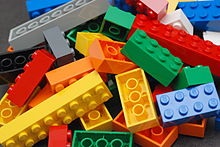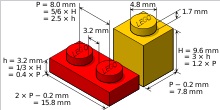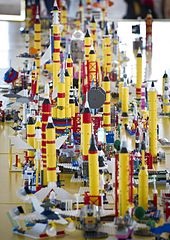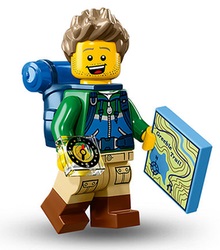|
|
| |
|
|
| |
|
|
|
|
| |
 |
| Lego bricks. |
Lego
Lego, also called LEGO, is a type of building toy
created and made by the Lego Group, a company in
Denmark. "Lego Bricks" are colorful plastic building
blocks that can be joined together easily. Lego bricks
are joined together by studs on the top, and holes in
the bottom of the brick commonly known as the
stud-and-tube connection. LEGO is the most popular
building toy in the world.
The Lego company was started by Ole Kirk Christiansen a
Danish toy maker in 1935. Christiansen made wooden toys
for children. He made and sold his first plastic Lego
sets in the 1940s. Since then, Lego toys have become
very popular and are known and loved by people around
the world kids and adults alike.
Lego bricks come in many shapes and sizes. There are
wheels, car screens, and plants. Lego bricks can be
joined together in many ways. Vehicles, buildings and
even robots can all be built with Lego bricks.
Almost all the bricks from Lego sets can fit together.
New bricks made today can fit with old bricks made years
ago. The bricks can join together no matter which set
they come from. Lego has become so popular that people
sometimes use the word "Lego" to talk about any sort of
building blocks. There are millions of LEGO fans and
conventions around the world. |
|
 |
| Dimensions of some
standard Lego bricks and plates. |
History
The Lego Group began in the workshop of Ole Kirk
Christiansen (1891–1958), a carpenter from Billund,
Denmark, who began making wooden toys in 1932. In 1934,
his company came to be called "Lego", derived from the
Danish phrase leg godt, which means "play well". In
1947, Lego expanded to begin producing plastic toys. In
1949 Lego began producing, among other new products, an
early version of the now familiar interlocking bricks,
calling them "Automatic Binding Bricks". These bricks
were based in part on the Kiddicraft Self-Locking
Bricks, which were patented in the United Kingdom in
1939 and released in 1947. Lego modified the design of
the Kiddicraft brick after examining a sample that they
received from the supplier of an injection-molding
machine that Lego purchased. The bricks, originally
manufactured from cellulose acetate, were a development
of the traditional stackable wooden blocks of the time. |
 |
| Lego building at
NASA's Kennedy Space Center. |
The Lego Group's motto is det bedste er ikke for godt
which means roughly "only the best is the best" (more
literally "the best is never too good"). This motto,
which is still used today, was created by Christiansen
to encourage his employees never to skimp on quality, a
value he believed in strongly. By 1951 plastic toys
accounted for half of the Lego company's output, even
though the Danish trade magazine Legetøjs-Tidende
("Toy-Times"), visiting the Lego factory in Billund in
the early 1950s, felt that plastic would never be able
to replace traditional wooden toys. Although a common
sentiment, Lego toys seem to have become a significant
exception to the dislike of plastic in children's toys,
due in part to the high standards set by Ole Kirk.
By 1954, Christiansen's son, Godtfred, had become the
junior managing director of the Lego Group. It was his
conversation with an overseas buyer that led to the idea
of a toy system. Godtfred saw the immense potential in
Lego bricks to become a system for creative play, but
the bricks still had some problems from a technical
standpoint: their locking ability was limited and they
were not versatile. In 1958, the modern brick design was
developed; it took five years to find the right material
for it, ABS (acrylonitrile butadiene styrene) polymer.
The modern Lego brick design was patented on 28 January
1958.
The Lego Group's Duplo product line was introduced in
1969 and is a range of simple blocks whose lengths
measure twice the width, height and depth of standard
Lego blocks and are aimed towards younger children. |
 |
| A Lego Minifigures
hiker, released 2016. |
In 1978, Lego produced the first minifigures, which have
since become a staple in most sets.
In May 2011, Space Shuttle Endeavour mission STS-134
brought 13 Lego kits to the International Space Station,
where astronauts built models to see how they would
react in microgravity, as a part of the Lego Bricks in
Space program.
In May 2013, the largest model ever created was
displayed in New York City and was made of over 5
million bricks; a 1:1 scale model of an X-wing fighter.
Other records include a 112-foot (34 m) tower and a 4 km
(2.5 mi) railway.
In February 2015, Lego replaced Ferrari as the "world's
most powerful brand."
In popular culture
Lego's popularity is demonstrated by its wide
representation and usage in many forms of cultural
works, including books, films and art work. It has even
been used in the classroom as a teaching tool. In the
US, Lego Education North America is a joint venture
between Pitsco, Inc. and the educational division of the
Lego Group.
In 1998, Lego bricks were one of the original inductees
into the National Toy Hall of Fame at The Strong in
Rochester, New York.
Design
Lego pieces of all varieties constitute a universal
system. Despite variation in the design and the purposes
of individual pieces over the years, each piece remains
compatible in some way with existing pieces. Lego bricks
from 1958 still interlock with those made in the current
time, and Lego sets for young children are compatible
with those made for teenagers. Six bricks of 2 × 4 studs
can be combined in 915,103,765 ways.
Each Lego piece must be manufactured to an exacting
degree of precision. When two pieces are engaged they
must fit firmly, yet be easily disassembled. The
machines that manufacture Lego bricks have tolerances as
small as 10 micrometres.
Primary concept and development work takes place at the
Billund headquarters, where the company employs
approximately 120 designers. The company also has
smaller design offices in the UK, Spain, Germany, and
Japan which are tasked with developing products aimed
specifically at these markets. The average development
period for a new product is around twelve months, split
into three stages. The first stage is to identify market
trends and developments, including contact by the
designers directly with the market; some are stationed
in toy shops close to holidays, while others interview
children. The second stage is the design and development
of the product based upon the results of the first
stage. As of September 2008 the design teams use 3D
modeling software to generate CAD drawings from initial
design sketches. The designs are then prototyped using
an in-house stereolithography machine. These prototypes
are presented to the entire project team for comment and
for testing by parents and children during the
"validation" process. Designs may then be altered in
accordance with the results from the focus groups.
Virtual models of completed Lego products are built
concurrently with the writing of the user instructions.
Completed CAD models are also used in the wider
organisation, for marketing and packaging.
Lego Digital Designer is an official piece of Lego
software for Mac OS X and Windows which allows users to
create their own digital Lego designs. The program once
allowed customers to order their custom designs with a
service to ship physical models from Digital Designer to
consumers; the service ended in 2012. |
 |
| A Lego store in
Canada. |
Manufacturing
Since 1963, Lego pieces have been manufactured from a
strong, resilient plastic known as acrylonitrile
butadiene styrene (ABS). As of September 2008, Lego
engineers use the NX CAD/CAM/CAE PLM software suite to
model the elements. The software allows the parts to be
optimized by way of mould flow and stress analysis.
Prototype moulds are sometimes built before the design
is committed to mass production. The ABS plastic is
heated to 232 °C (450 °F) until it reaches a dough-like
consistency. It is then injected into the moulds at
pressures between 25 and 150 tonnes, and takes
approximately 15 seconds to cool. The moulds are
permitted a tolerance of up to twenty micrometres, to
ensure the bricks remain connected. Human inspectors
check the output of the moulds, to eliminate significant
variations in colour or thickness. According to the Lego
Group, about eighteen bricks out of every million fail
to meet the standard required. Lego factories recycle
all but about 1 percent of their plastic waste from the
manufacturing process. If the plastic cannot be re-used
in Lego bricks, it is processed and sold on to
industries that can make use of it.
Manufacturing of Lego bricks occurs at several locations
around the world. Moulding is done in Billund;
Nyíregyháza, Hungary; Monterrey, Mexico and most
recently in Jiaxing, China. Brick decorations and
packaging are done at plants in Denmark, Hungary, Mexico
and Kladno in the Czech Republic. The Lego Group
estimates that in five decades it has produced 400
billion Lego blocks. Annual production of Lego bricks
averages approximately 36 billion, or about 1140
elements per second. According to an article in
BusinessWeek in 2006, Lego could be considered the
world's No. 1 tire manufacturer; the factory produces
about 306 million small rubber tires a year. The claim
was reiterated in 2012.
In December 2012, the BBC's More or Less radio program
asked the Open University's engineering department to
determine "how many Lego bricks, stacked one on top of
the other, it would take for the weight to destroy the
bottom brick?" Using a hydraulic testing machine, the
engineering department determined the average maximum
force a 2×2 Lego brick can stand is 4,240 newtons; since
an average 2×2 Lego brick has a mass of 1.152 grams
(0.0406 oz), according to their calculations it would
take a stack of 375,000 bricks to cause the bottom brick
to collapse, which represents a stack 3,591 metres
(11,781 ft) in height.
Private tests have shown several thousand
assembly-disassembly cycles before the bricks begin to
wear out, although Lego tests show fewer cycles. |
|
 |
| Lego sets of the
Lego City theme. |
Lego set themes
Since the 1950s, the Lego Group has released thousands
of sets with a variety of themes, including space,
robots, pirates, trains, Vikings, castle, dinosaurs,
undersea exploration, and wild west. Some of the classic
themes that continue to the present day include Lego
City (a line of sets depicting city life introduced in
1973) and Lego Technic (a line aimed at emulating
complex machinery, introduced in 1977).
Over the years, Lego has licensed themes from numerous
cartoon and film franchises and even some from video
games. These include Batman, Indiana Jones, Pirates of
the Caribbean, Harry Potter, Star Wars, and Minecraft.
Although some of the licensed themes, Lego Star Wars and
Lego Indiana Jones, had highly successful sales, Lego
has expressed a desire to rely more upon their own
characters and classic themes, and less upon licensed
themes related to movie releases.
For the 2012 Summer Olympics in London Lego released a
special Lego Minifigures serie and for the 2016 Summer
Olympics and 2016 Summer Paralympics in Rio, Lego
released a kit with the Olympic and Paralympic mascots
Vinicius and Tom.
One of the largest Lego sets commercially produced was a
minifig-scaled edition of the Star Wars Millennium
Falcon. Designed by Jens Kronvold Fredericksen, it was
released in 2007 and contained 5,195 pieces. It was
surpassed by a 5,922-piece Taj Mahal. A redesigned
Millenium Falcon recently retook the top spot in 2017
with 7,541 pieces.
Robotics themes
Lego also initiated a robotics line of toys called 'Mindstorms'
in 1999, and has continued to expand and update this
range ever since. The roots of the product originate
from a programmable brick developed at the MIT Media
Lab, and the name is taken from a paper by Seymour
Papert, a computer scientist and educator who developed
the educational theory of constructionism, and whose
research was at times funded by the Lego Group.
The programmable Lego brick which is at the heart of
these robotics sets has undergone several updates and
redesigns, with the latest being called the 'EV3' brick,
being sold under the name of Lego Mindstorms EV3. The
set includes sensors that detect touch, light, sound and
ultrasonic waves, with several others being sold
separately, including an RFID reader.
The intelligent brick can be programmed using official
software available for Windows and Mac computers, and is
downloaded onto the brick via Bluetooth or a USB cable.
There are also several unofficial programs and
compatible programming languages that have been made to
work with the brick, and many books have been written to
support this community.
There are several robotics competitions which use the
Lego robotics sets. The earliest is Botball, a national
U.S. middle- and high-school competition stemming from
the MIT 6.270 Lego robotics tournament. Other Lego
robotics competitions include Junior FIRST LEGO League (Jr.FLL)
for students ages 6–9 and FIRST Lego League (FLL) for
students ages 9–16 (age 9–14 in the United States,
Canada, and Mexico). Jr.FLL and FLL offer real-world
engineering challenges to participants. FLL uses
Lego-based robots to complete tasks. Jr.FLL participants
build models out of Lego elements. In its 2010 season,
there were 16,070 FLL teams in over 55 countries. In its
2010 season, there were 2,147 Jr.FLL teams with 12,882
total student participants in the United States and
Canada. The international RoboCup Junior football
competition involves extensive use of Lego Mindstorms
equipment which is often pushed to its extreme limits.
The capabilities of the Mindstorms range have now been
harnessed for use in Iko Creative Prosthetic System, a
prosthetic limbs system designed for children. Designs
for these Lego prosthetics allow everything from
mechanical diggers to laser-firing spaceships to be
screwed on to the end of a child's limb. Iko is the work
of the Chicago-based Colombian designer Carlos Arturo
Torres, and is a modular system that allows children to
customise their own prosthetics with the ease of
clicking together plastic bricks. Designed with Lego's
Future Lab, the Danish toy company's experimental
research department, and Cirec, a Colombian foundation
for physical rehabilitation, the modular prosthetic
incorporates myoelectric sensors that register the
activity of the muscle in the stump and send a signal to
control movement in the attachment. A processing unit in
the body of the prosthetic contains an engine compatible
with Lego Mindstorms, the company's robotics line, which
lets the wearer build an extensive range of customised,
programmable limbs.
Related services
Official website
First launched in 1996, the Lego website has developed
over the years, and provides many extra services beyond
an online store and a product catalogue. There are also
moderated message boards that were founded in 2001. The
site also includes instruction booklets for all Lego
sets dating back to 2002.
My Lego Network is a social networking site that
involves items, blueprints, ranks, badges which are
earned for completing certain tasks, trading and
trophies called masterpieces which allow users to
progress to go to the next rank. The website has a built
in inbox which allows users to send pre written messages
to one another. The Lego Network includes automated
non-player characters within called "Networkers", who
are able to do things which normal users cannot do,
sending custom messages, and selling masterpieces and
blueprints. The site also has modules which are set up
on the user's page that give the user items, or that
display picture compositions. Before My Lego Network,
there were Lego Club Pages, which essentially held the
same purpose, although the design lacked complex
interaction. |
 |
| A model of Trafalgar
Square, London, in Legoland Windsor. |
Theme parks
Merlin Entertainments operates seven Legoland amusement
parks, the original in Billund, Denmark, the second in
Windsor, England, the third in Günzburg, Germany, the
fourth in Carlsbad, California, the fifth in Winter
Haven, Florida, the sixth in Nusajaya, Malaysia and the
seventh in Dubai, United Arab Emirates. and the eighth
in Shanghai, Peoples of Republic of China. On 13 July
2005, the control of 70% of the Legoland parks was sold
for $460 million to the Blackstone Group of New York
while the remaining 30% is still held by Lego Group.
There are also eight Legoland Discovery Centres, two in
Germany, four in the United States, one in Japan and one
in the United Kingdom. Two Legoland Discovery Centres
opened in 2013: one at the Westchester Ridge Hill
shopping complex in Yonkers, NY and one at the Vaughan
Mills in Vaughan, Ontario, Canada. Another has opened at
the Meadowlands complex in East Rutherford, New Jersey
in 2014. |
|
LEGO Video Games
Many LEGO video games are being created for different
video game systems. LEGO video games usually come from
LEGO themes, such as LEGO Star Wars and Lego Indiana
Jones. Lego Star Wars is a famous theme and it has three
video games. A new game Harry Potter is a video game
which came out before the new Harry Potter theme but
made after the old Harry Potter. LEGO Star Wars 1 and 2
are some of the best selling video games and are about
to get a new version of LEGO Star Wars, LEGO Star Wars
3: The Clone Wars.
In LEGO Clone Wars, you can play as most of your
favorite characters, like Rex, Yoda, Cody, and a lot of
others. Also, you can face fearsome monsters like the
Rancor.The newest game from LEGO is LEGO Universe, a
massively multi-player online game. new games for the
movie will be loaded with legos.
There has been a Lego game that is very popular Lego
Dimensions. The starter pack is expensive but the game
is very popular. The fun packs are the cheapest pack to
extend the game. The level and team packs are the
expensive packs.The first ever lego video game was
published in 2001
Television and movies
The first official Lego film was the straight-to-DVD
release of Bionicle: Mask of Light in 2003 developed by
Creative Capers Entertainment and distributed by Miramax
Home Entertainment. Several other straight-to-DVD
computer animated Bionicle sequels and Hero Factory
movies were produced in the following years. Lego: The
Adventures of Clutch Powers was released on DVD in
February 2010, a computer-animated film made by
Tinseltown Toons.
The Lego Movie, a feature film based on Lego toys, was
released by Warner Bros. in February 2014. It featured
Chris Pratt in the lead role, with substantial
supporting characters voiced by Elizabeth Banks, Will
Arnett, Morgan Freeman, Liam Neeson, Alison Brie, Will
Ferrell and Nick Offerman. A contest was held for
contestants to submit designs for vehicles to be used in
the film. After the release of The Lego Movie,
independent Canadian toy retailers reported issues with
shortages of Lego products and cited cancellations of
Lego pre-orders without warning as a motive to stock
compatible, rival products.
A spin-off of The Lego Movie, entitled The Lego Batman
Movie, directed by Chris McKay was released in the US in
February 2017.
In June 2013, it was reported that Warner Bros. was
developing a feature film adaptation of Lego Ninjago.
Brothers Dan Hageman and Kevin Hageman were attached to
write the adaptation, while Dan Lin and Roy Lee, along
with Phil Lord and Chris Miller, were announced as
producers. The film, The Lego Ninjago Movie, was
released in September 2017. A computer-generated
animated series based on Lego Ninjago: Masters of
Spinjitzu began in 2011, and another based on Legends of
Chima began in 2013. A television series of Lego City
has also been announced. |
|
 Kiddle: Lego Kiddle: Lego
Wikipedia: Lego |
|
|
|
|
|
|
|
|
|
|
|
|
|
|
|
|
Search Fun Easy English |
|
|
|
|
|
|
|
|
|
|
|
|
|
|
|
About
Contact
Copyright
Resources
Site Map |